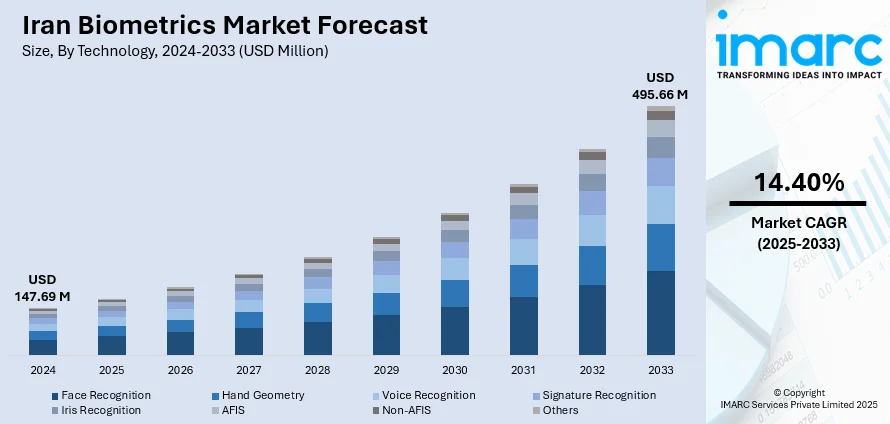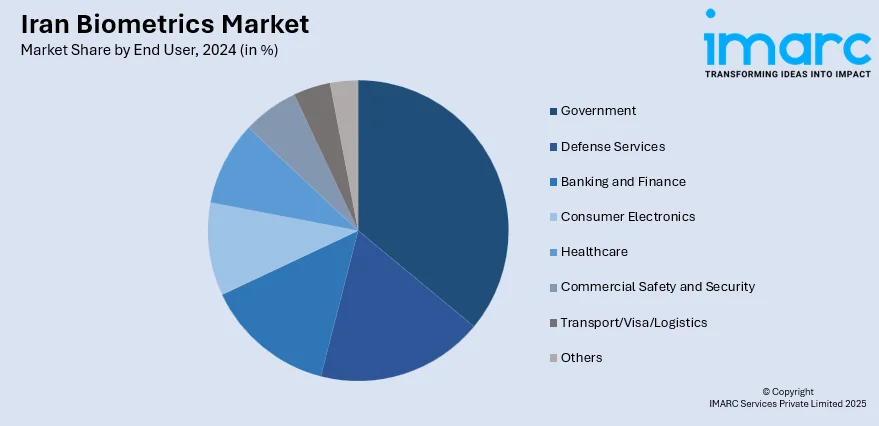
Iran Biometrics Market Size, Share, Trends and Forecast by Technology, Functionality, Component, Authentication, End User, and Region, 2025-2033
Iran Biometrics Market Overview:
The Iran biometrics market size reached USD 147.69 Million in 2024. Looking forward, the market is expected to reach USD 495.66 Million by 2033, exhibiting a growth rate (CAGR) of 14.40% during 2025-2033. The market is witnessing steady growth, driven by increasing adoption in border security, government digital transformation, and enterprise workforce management. Rising demand for secure authentication across immigration control, public services, and corporate sectors highlights biometrics as a critical tool for efficiency and fraud prevention, ultimately strengthening Iran biometrics market share.
|
Report Attribute
|
Key Statistics
|
|---|---|
|
Base Year
|
2024
|
|
Forecast Years
|
2025-2033
|
|
Historical Years
|
2019-2024
|
| Market Size in 2024 | USD 147.69 Million |
| Market Forecast in 2033 | USD 495.66 Million |
| Market Growth Rate 2025-2033 | 14.40% |
Iran Biometrics Market Trends:
Rising Need for Border Security and Immigration Control
The geographic location of Iran, where borders are shared with several nations, makes highly suitable border management and immigration control solutions a pressing necessity. Rising levels of cross-border travel, security challenges in the region, and illegal migratory issues are making the government further fortify security infrastructure through a biometric system. Technologies of fingerprint recognition, face recognition, and iris recognition are being introduced on border checkpoints, at the airports and immigration offices to precisely identify travelers and make sure they do not enter unlawfully. With these systems, passengers can also be processed faster, which enhances security and efficiency. The presence of geopolitical tensions between neighboring countries and the need to control the high traffic flow along the borders make biometric technologies the necessary facilities towards ensuring national border security. This growing reliance on biometrics for immigration management is a critical factor accelerating the Iran biometrics market growth.

To get more information on this market, Request Sample
Expansion of E-Government and Digital Transformation Initiatives
Iran is actively promoting e-government projects and digital transformation to modernize public administration and service delivery. As part of these initiatives, biometric authentication plays a key role in ensuring secure and reliable access to government services, online portals, and citizen databases. Biometric-enabled systems help reduce identity fraud, streamline citizen registration, and enhance transparency in administrative operations. For example, integrating fingerprint and facial recognition into national identity programs allows citizens to access healthcare, taxation, and welfare services more securely. These initiatives also support Iran’s vision of improving efficiency in governance while promoting accountability. The growing push toward digital transformation is steadily expanding the use of biometrics across multiple sectors, making it a vital driver of the country’s market growth.
Integration in Workforce Management and Enterprise Security
Enterprises and organizations across Iran are increasingly adopting biometric technologies for workforce management, access control, and data security. Businesses are replacing traditional timekeeping and card-based systems with fingerprint and facial recognition solutions to improve accuracy and reduce employee attendance fraud. Biometric-based access control systems are also being deployed to secure sensitive data, research facilities, and financial institutions, ensuring only authorized personnel gain entry. In addition, the rise of remote work and digital collaboration has created new cybersecurity challenges, prompting companies to implement biometric authentication for digital platforms and secure logins. This growing integration of biometrics into workplace security and enterprise management highlights its role in improving efficiency, reducing risks, and driving market adoption in Iran.
Iran Biometrics Market Segmentation:
IMARC Group provides an analysis of the key trends in each segment of the market, along with forecasts at the country and regional levels for 2025-2033. Our report has categorized the market based on technology, functionality, component, authentication, and end user.
Technology Insights:
- Face Recognition
- Hand Geometry
- Voice Recognition
- Signature Recognition
- Iris Recognition
- AFIS
- Non-AFIS
- Others
The report has provided a detailed breakup and analysis of the market based on technology. This includes face recognition, hand geometry, voice recognition, signature recognition, iris recognition, AFIS, Non-AFIS, and others.
Functionality Insights:
- Contact
- Non-contact
- Combined
A detailed breakup and analysis of the market based on the functionality have also been provided in the report. This includes contact, non-contact, and combined.
Component Insights:
- Hardware
- Software
A detailed breakup and analysis of the market based on the component have also been provided in the report. This includes hardware and software.
Authentication Insights:
- Single-Factor Authentication
- Multifactor Authentication
A detailed breakup and analysis of the market based on the authentication have also been provided in the report. This includes single-factor authentication and multifactor authentication.
End User Insights:

- Government
- Defense Services
- Banking and Finance
- Consumer Electronics
- Healthcare
- Commercial Safety and Security
- Transport/Visa/Logistics
- Others
A detailed breakup and analysis of the market based on the end user have also been provided in the report. This includes government, defense services, banking and finance, consumer electronics, healthcare, commercial safety and security, transport/visa/logistics, and others.
Regional Insights:
- Tehran
- Khuzestan
- Bushehr
- Esfahan
- Khorasan
- Others
The report has also provided a comprehensive analysis of all the major regional markets, which include Tehran, Khuzestan, Bushehr, Esfahan, Khorasan, and others.
Competitive Landscape:
The market research report has also provided a comprehensive analysis of the competitive landscape. Competitive analysis such as market structure, key player positioning, top winning strategies, competitive dashboard, and company evaluation quadrant has been covered in the report. Also, detailed profiles of all major companies have been provided.
Iran Biometrics Market Report Coverage:
| Report Features | Details |
|---|---|
| Base Year of the Analysis | 2024 |
| Historical Period | 2019-2024 |
| Forecast Period | 2025-2033 |
| Units | Million USD |
| Scope of the Report |
Exploration of Historical Trends and Market Outlook, Industry Catalysts and Challenges, Segment-Wise Historical and Future Market Assessment:
|
| Technologies Covered | Face Recognition, Hand Geometry, Voice Recognition, Signature Recognition, Iris Recognition, AFIS, Non-AFIS, Others |
| Functionalities Covered | Contact, Non-contact, Combined |
| Components Covered | Hardware, Software |
| Authentications Covered | Single-Factor Authentication, Multifactor Authentication |
| End User Covered | Government, Defense Services, Banking and Finance, Consumer Electronics, Healthcare, Commercial Safety and Security, Transport/Visa/Logistics, Others |
| Regions Covered | Tehran, Khuzestan, Bushehr, Esfahan, Khorasan, Others |
| Customization Scope | 10% Free Customization |
| Post-Sale Analyst Support | 10-12 Weeks |
| Delivery Format | PDF and Excel through Email (We can also provide the editable version of the report in PPT/Word format on special request) |
Key Questions Answered in This Report:
- How has the Iran biometrics market performed so far and how will it perform in the coming years?
- What is the breakup of the Iran biometrics market on the basis of technology?
- What is the breakup of the Iran biometrics market on the basis of functionality?
- What is the breakup of the Iran biometrics market on the basis of component?
- What is the breakup of the Iran biometrics market on the basis of authentication?
- What is the breakup of the Iran biometrics market on the basis of end user?
- What is the breakup of the Iran biometrics market on the basis of region?
- What are the various stages in the value chain of the Iran biometrics market?
- What are the key driving factors and challenges in the Iran biometrics market?
- What is the structure of the Iran biometrics market and who are the key players?
- What is the degree of competition in the Iran biometrics market?
Key Benefits for Stakeholders:
- IMARC’s industry report offers a comprehensive quantitative analysis of various market segments, historical and current market trends, market forecasts, and dynamics of the Iran biometrics market from 2019-2033.
- The research report provides the latest information on the market drivers, challenges, and opportunities in the Iran biometrics market.
- Porter's five forces analysis assist stakeholders in assessing the impact of new entrants, competitive rivalry, supplier power, buyer power, and the threat of substitution. It helps stakeholders to analyze the level of competition within the Iran biometrics industry and its attractiveness.
- Competitive landscape allows stakeholders to understand their competitive environment and provides an insight into the current positions of key players in the market.
Need more help?
- Speak to our experienced analysts for insights on the current market scenarios.
- Include additional segments and countries to customize the report as per your requirement.
- Gain an unparalleled competitive advantage in your domain by understanding how to utilize the report and positively impacting your operations and revenue.
- For further assistance, please connect with our analysts.
 Request Customization
Request Customization
 Speak to an Analyst
Speak to an Analyst
 Request Brochure
Request Brochure
 Inquire Before Buying
Inquire Before Buying




.webp)




.webp)












